

Establishing Real-World Connections in Projects (Keys to PBL Series Part 1) Peggy: Usually by starting with an authentic problem in the community, or in the neighborhood, you anchor the unit with a driving question.
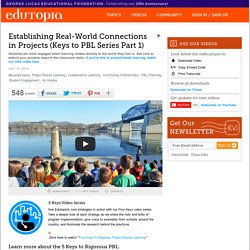
So students are given this question, for example, "What's in our water? And how did it get there? " And then the students choose different paths to explore that question. Sheela: Start to examine what's happening in your local community. Embedding Assessment Throughout the Project (Keys to PBL Series Part 5) Peggy: Different than a traditional classroom, PBL's gonna integrate assessment throughout the project.
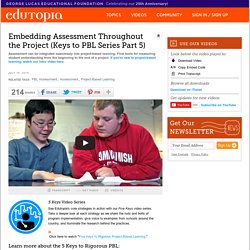
Because these projects are multi-week projects, you need to keep on top of students and build in opportunities to assess where they are and what they're learning as you go along. Sheela: From the minute a teacher introduces that learning target for the lesson, or engages in strategic observation, we feel that the assessment process is in play. Liza: It's not a test at the end of the week or the end of the unit.
Facilitating Learning in a Student-Driven Environment (Keys to PBL Series Part 4) Liza: So when you're working on projects and you really have student-driven lessons, it can be scary because you don't feel like you're in control, but you really are.
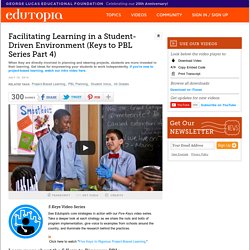
If you are planning the right way ahead of time, you are scaffolding every single aspect of that lesson and what the students are doing. You may say to yourself, it's way too much, there's too much to do. But that hard work in the beginning allows it to be completely student-driven and they know that this is their education and that I'm here to support them. I'm not here to tell them what they need to know. Teacher: What else can we use the lake for besides drinking and fishing? Sheela: So it's not about just giving kids a worksheet that the teacher has created to complete. Teacher: Just think for a minute and reflect on this idea. Peggy: Teachers need to be very conscious of building in opportunities for reflection, because that's the thing that's very easy to forget. Liza: So we have learning targets for every day.
Structuring Collaboration for Student Success (Keys to PBL Series Part 3) Peggy: The teacher doesn’t just throw control to the students and say, "Let me know what you figure out.
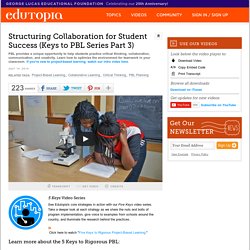
" She really has to plan ahead of time, she has to figure out how to group the students so that they're the most productive. She has to scaffold their work, so she provides hints or clues or templates, worksheets is necessary, to kinda show them what they need to do first, what they might consider doing next. She has to teach them how to work together.
Teamwork is not something that comes naturally, especially for younger students. Building Rigorous Projects That Are Core to Learning (Keys to PBL Series Part 2) Steven: A lot of people think that Project Based Learning is fluff.
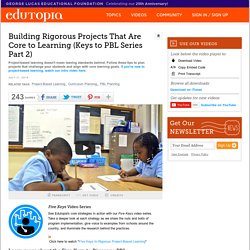
So what we did, instead of having a three-column rubric that has "Unsatisfactory, Proficient and Advanced," we added a fourth column. It is the "Standards," what has to be taught. Climbing the Project-based Learning Mountain. 1.
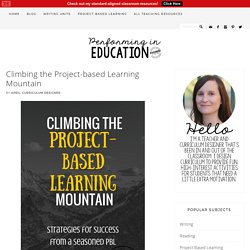
Start at a trail marker. The best way to plan a PBL is to start with one single standard in one subject. I usually plan around Math for my project-based learning activities. Once you come up with a topic that goes with this subject, you will find many other standards that it meets. Remember to envision the standard being used in real life. Sketch out a basic outline, then come up with a guiding question. 2. Do you know someone that’s done project-based learning before? 3. Before you begin project-based learning with your students, ask yourself what materials will make the project stand out. VIDEO GENIAL DE PSICOLOGIA. Programa Redes TVE: ¿Crisis educativa? Enseñar a pensar: el aprendizaje del futuro. Probablemente, todos los educadores coincidiríamos en el hecho que los contenidos que transmitimos con afán a nuestros alumnos son cada vez más inciertos.
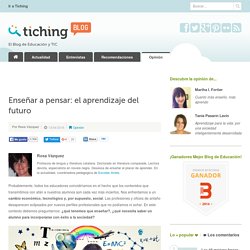
Nos enfrentamos a un cambio económico, tecnológico y, por supuesto, social. Las profesiones y oficios de antaño desaparecen eclipsados por nuevos perfiles profesionales que no podíamos ni soñar. En este contexto debemos preguntarnos: ¿qué tenemos que enseñar? , ¿qué necesita saber un alumno para incorporarse con éxito a la sociedad? Nuestro fin debería ser formar personas competentes, capaces de movilizar conjuntamente “habilidades prácticas, conocimientos, motivación, valores éticos, actitudes, emociones y otros componentes sociales y de comportamiento” (OCDE, 2000). El aprendizaje fundamental debe ser enseñar a aprender, es decir, enseñar a pensar de forma estructurada: qué tenemos que aprender, cómo tenemos que hacerlo y en qué fase de este proceso nos encontramos. Els 7 Principis de l'Aprenentatge by Marc Franco Sola on Prezi. Five Keys to Rigorous Project-Based Learning.
Treball per Projectes LLG8/9/16. Image.